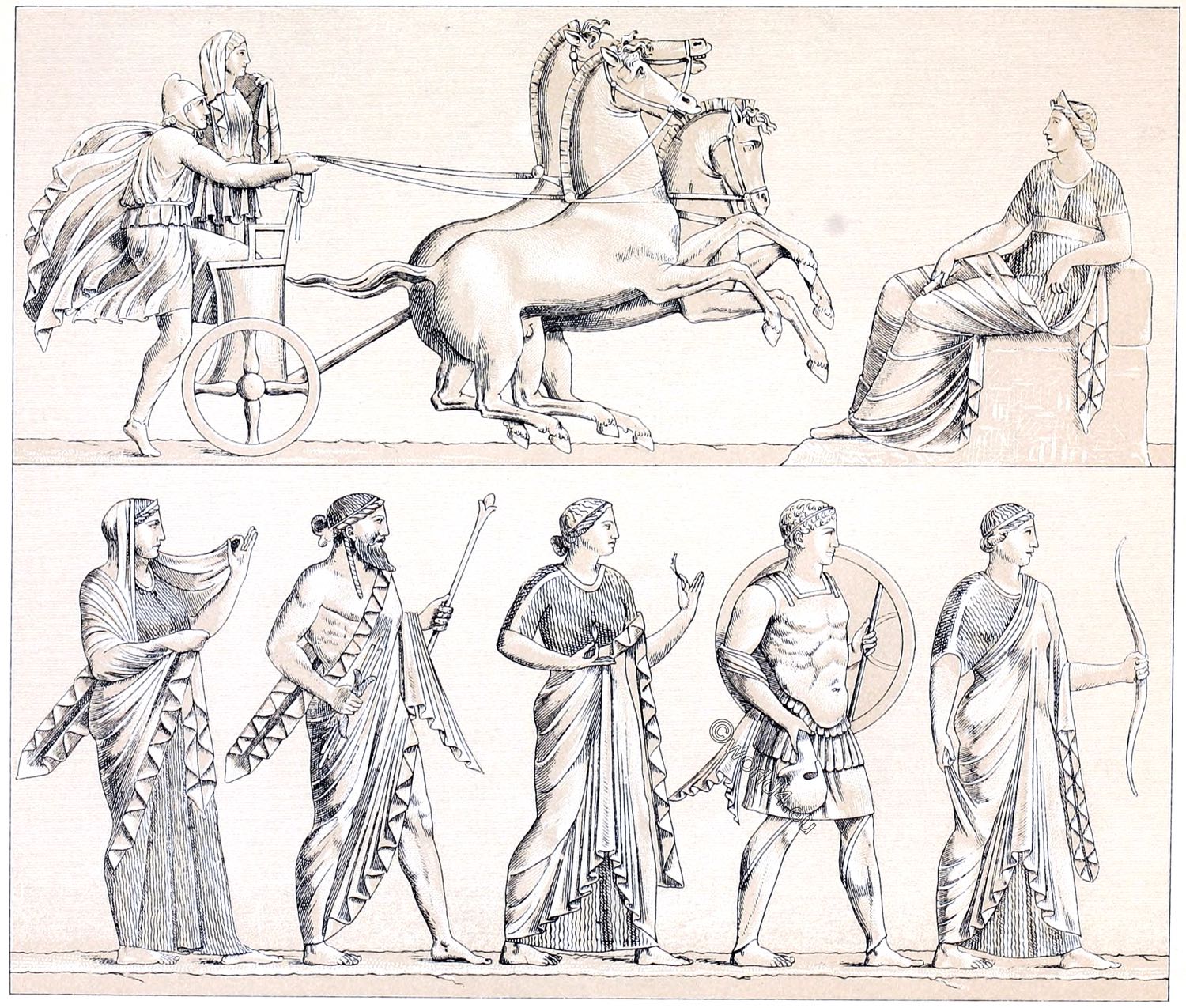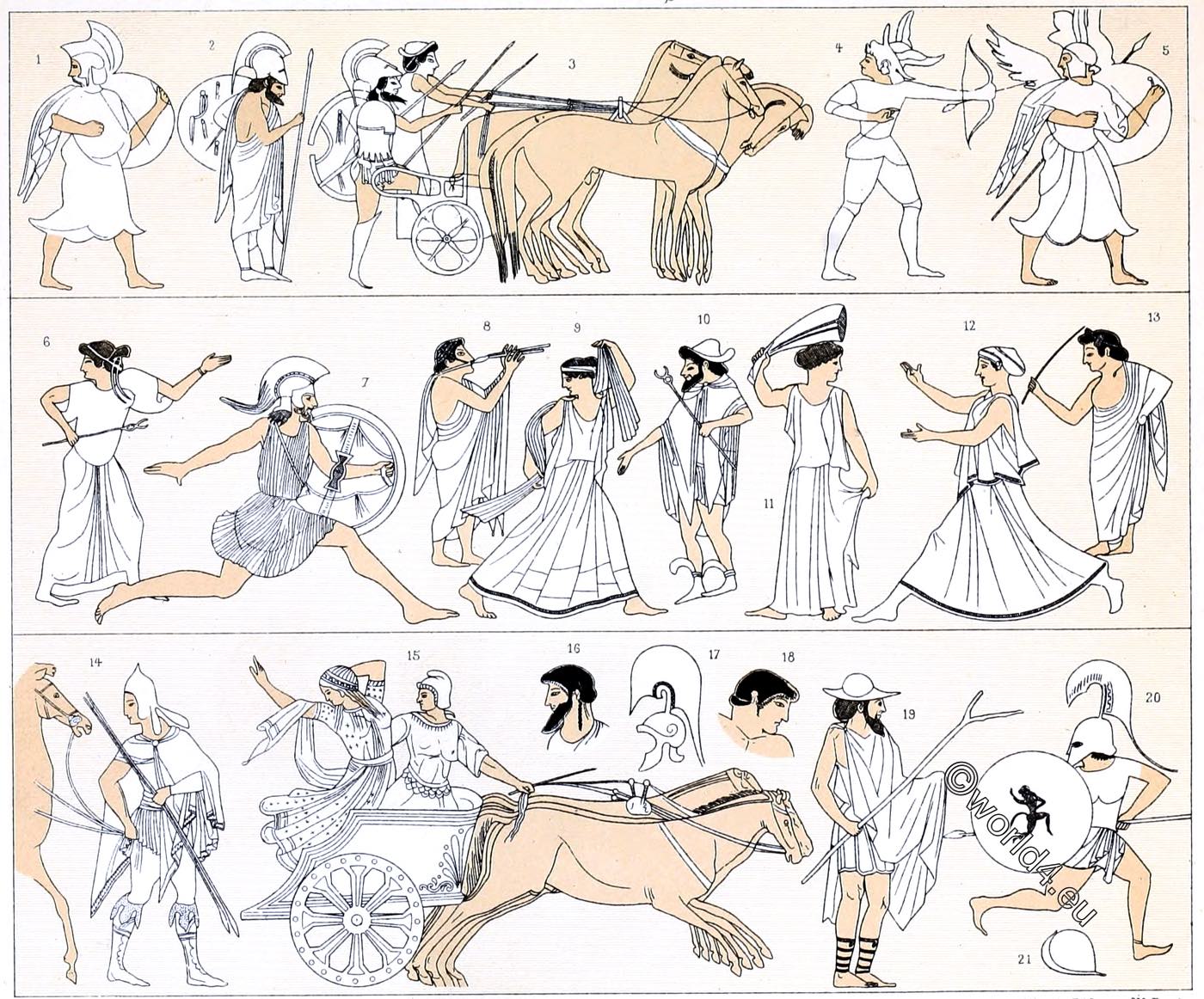Ancient Egyptian culture. Costumes, Weapons, Instruments.
Brief overview of the cultural epochs by using selected characteristic elements of style. Architecture, costumes, decoration, furniture, weapons.
- Pic 1., Egyptian Weapons, Instruments and Household Articles. Daggers, Egyptian House, Scepters, Mirror, Shield, Sandal, Vases, Harp, Fan, Furniture.
- Pic 2., Egyptian Architectural Decoration
- Pic 3., Egyptian Costumes, Ancient Times. Warrior, King, Queen, Man and Lady of Rank, King in ceremonial Costume.
Domestic utensils in ancient Egypt, by Didot Paris 1878
Above pic: Egyptian mirrors, make-up vessels, zermonial objects
“Costumes of the ancient Egyptians” by Albert Kretschmer (1825-1891)
Costume illustration: 1.2. Egyptian woman and man of the people. 3.4.5. Noble Egyptians. 6.7. Noble Egyptians. 8 Fan carrier of the Pharaoh (Egyptian king). 9 Egyptian Princess. 10th Prince. 11th Pharaoh. 12th Priest. 13th Egyptian Queen

1.2.3.4.5.6. Egyptian priests. 7.8.11.12. Egyptian warrior. 9. King in battle dress. 10th King in a ceremony clothing.
“Courtly Music and Furnishings of Ancient Egypt” by Didot Paris.
Ancient Egypt Music instruments, harp, eunuchs, loom, comb, oil lamps, wigs.
Adornments and weapons of the Egyptians in ancient times.
1-3 Field signs. 4-9. Weapons. 10-13. Scepter. 14 Hook Stock. 15-20. Vessels. 21-22. Shields. 23:24. Rings. 25 Parts of a collar. 26 27 Earrings. 28 Mirror. 29.30.31.34.35. Egyptian music instruments. 32.33. Fan. 36 Uraeus. 37-39. Foot coverings, sandals, shoes. 40.41. Baskets. 42 Table. 43.46. Chair.
Egyptians in the fight, by Didot Paris.

Upper row: Chariot with charioteer and soldiers. Various shields and chariots. Lower row: Nubian elite soldier. Pharaoh in the war regalia in combat. Various battle axes. Behead of an enemy. Swords and spears.
A History of Costume. The peoples of Antiquity.
The Egyptians clothing.
TO judge from the most ancient representation that we possess, the Egyptians of the Old Kingdom (c. 3000 B.C.) wore a loincloth made of woven material, which was wrapped several times round the body and kept in place by a girdle. In addition to this a wrap or a speckled skin was hung over the shoulders. This costume continued right up to the time when the so-called Old Kingdom reached its highest brilliance, and the beauty and costliness of material and draping were the only marks that distinguished monarch and nobles from the lower classes. By and by aflother item of dress was added—a somewhat close-fitting, one-piece skirt of expensive material, which was similarly fastened by means of a girdle.
The Kalasiris
The so-called kalasiris (Figs. 3-5), a garment for both sexes, which was introduced shortly after the establishment of the New Kingdom (c. 1000 B.C.), was a long robe quite unlike those just mentioned, differing from them both in cut and in the materials of which it was made. There was apparently more than one style of this garment. It was either a coat covering the body from the hips or the procardium to the abdomen, supported by a band passing over one shoulder, or it even reached as far up as the neck.
Some forms of it were sleeveless (Figs. 2 and 3), while others had short and narrow or long and fairly wide sleeves. This garment also varied in width. Sometimes it was wide and full, sometimes so close-fitting that it is difficult to understand how the wearer could walk. Most probably, therefore, there were two ways of making the kalasiris. Either it was woven or knitted in one piece so as to impart to it some elasticity and cause it to cling closely to the lower limbs of the wearer even when he moved; or it was made of pieces cut separately and sewn together at the sides. In the former case it resembled a narrow bag of the same width throughout its whole length, sometimes with sleeves fitted to it or knitted in it. This elastic type of kalasiris seems to have been made of material which was in most cases of close texture, but occasionally very loose and transparent. It is of course possible that the transparency was due to the stretching of material that was originally close in texture and to the consequent tearing of the threads or stitches.
The sewn type of kalasiris was a short garment somewhat resembling a woman’s petticoat. The width of the material determined the length of the garment, so that there was only one seam. The numerous folds were distributed at equal distances round the body. In some instances it was worn in apron fashion, and in that case it was not sewn at all. The long type of kalasiris that covered the body up to the neck was made from a rectangular piece of material twice as long as the garment (see Fig. 4). It was folded in the middle, and a hole was cut out to allow the head to pass through. The sides were then sewn together, gaps being left unsewn at the top to serve as armholes. When the garment was meant to be worn without a girdle the cut was slightly altered so as to make the material over the shoulders narrower than that lower down. This is indicated by the interior lines in Fig. 4. For the sleeved kalasiris the sleeves were either cut separately and sewn on or a slight change was made in the garment itself (Fig. 5). The material on both sides of the opening for the head was left as wide as the intended length of the sleeves. The lower edges of the portions forming the sleeves were sewn together when the sides of the garment were sewn.
Clothing of Egyptian women
The clothing of Egyptian women covered and concealed the person to a far greater extent than did the clothing of the men. The close-fitting, elastic type of kalasiris was the ancient national costume of the female population of the country. There were slight variations of style, but in all cases the garment was long enough to cover the ankles. In some it extended up to or beyond the breast (being held in place by shoulder straps), or even up to the neck. This last style was provided with sleeves.
The working class wore the same style of garment. In order to obtain greater freedom of movement they adopted various methods of tucking it up, and wore it much shorter than the upper classes did. In addition to the garments described above, various kinds of capes were worn both by men and women of the upper classes. The earliest type, which was in regular use as far back as the time of the Old Kingdom, was an almost circular shoulder-cape (Fig. 6), either closed or made to fasten behind. It varied in width, but never reached lower than the shoulder, and was made either of Unen painted in diverse colours or of very costly network.
Another style of cape, made only of transparent materials, fell from the shoulders to a little below the elbows. This cape was either almost circular in shape, with a hole in the centre to allow it to be passed over the head, or rectangular (Fig. 7). In the latter case the strips forming the cape were laid over the shoulders, gathered on the breast, and held in place by a clasp, so that the ends hung down loose. In putting on the almost circular cape just mentioned the narrow.
Amenophis IV and his Queen — New Kingdom sides on breast and back were gathered, thus giving rise to diagonal folds. As in the case of all ancient dress, the most important feature of the dress of the Egyptians was the draping. Each people had its own characteristic way of putting on garments that closely resembled each other in cut and style.
Related
Discover more from World4 Costume Culture History
Subscribe to get the latest posts sent to your email.





























